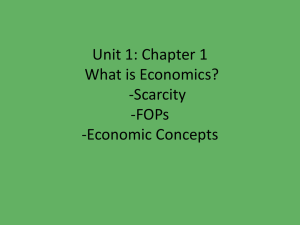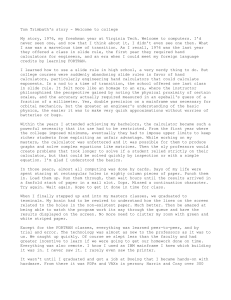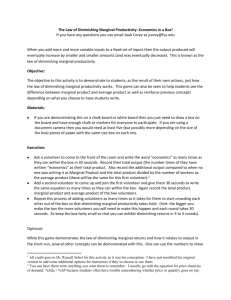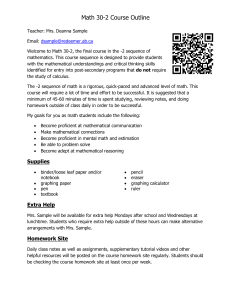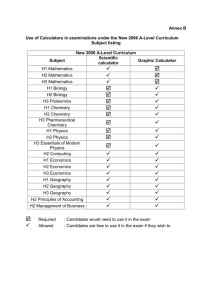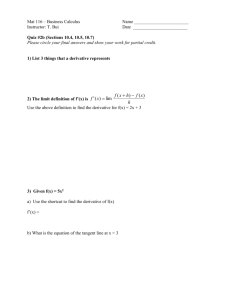The Production of Mathematical Problems
advertisement
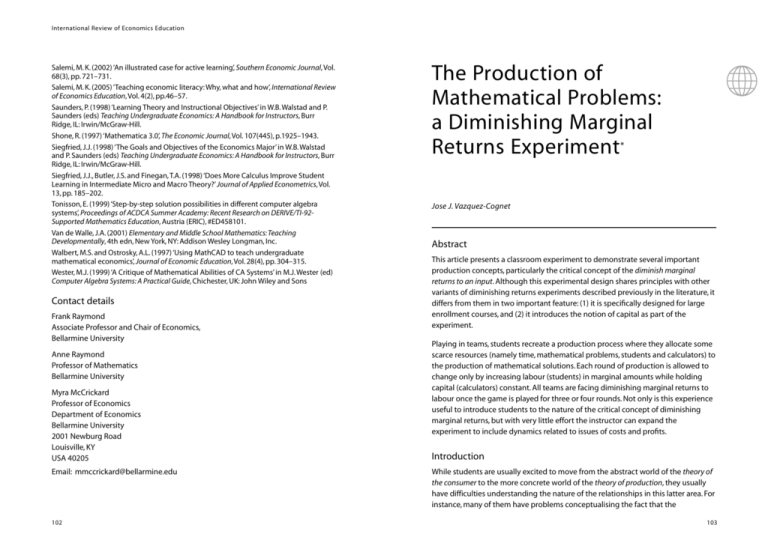
International Review of Economics Education Salemi, M. K. (2002) ‘An illustrated case for active learning’, Southern Economic Journal, Vol. 68(3), pp. 721–731. Salemi, M. K. (2005) ‘Teaching economic literacy: Why, what and how’, International Review of Economics Education, Vol. 4(2), pp.46–57. Saunders, P. (1998) ‘Learning Theory and Instructional Objectives’ in W.B. Walstad and P. Saunders (eds) Teaching Undergraduate Economics: A Handbook for Instructors, Burr Ridge, IL: Irwin/McGraw-Hill. Shone, R. (1997) ‘Mathematica 3.0’, The Economic Journal, Vol. 107(445), p.1925–1943. Siegfried, J.J. (1998) ‘The Goals and Objectives of the Economics Major’ in W.B. Walstad and P. Saunders (eds) Teaching Undergraduate Economics: A Handbook for Instructors, Burr Ridge, IL: Irwin/McGraw-Hill. Siegfried, J.J., Butler, J.S. and Finegan, T.A. (1998) ‘Does More Calculus Improve Student Learning in Intermediate Micro and Macro Theory?’ Journal of Applied Econometrics, Vol. 13, pp. 185–202. Tonisson, E. (1999) ‘Step-by-step solution possibilities in different computer algebra systems’, Proceedings of ACDCA Summer Academy: Recent Research on DERIVE/TI-92Supported Mathematics Education, Austria (ERIC), #ED458101. Van de Walle, J.A. (2001) Elementary and Middle School Mathematics: Teaching Developmentally, 4th edn, New York, NY: Addison Wesley Longman, Inc. Walbert, M.S. and Ostrosky, A.L. (1997) ‘Using MathCAD to teach undergraduate mathematical economics’, Journal of Economic Education, Vol. 28(4), pp. 304–315. Wester, M.J. (1999) ‘A Critique of Mathematical Abilities of CA Systems’ in M.J. Wester (ed) Computer Algebra Systems: A Practical Guide, Chichester, UK: John Wiley and Sons Contact details Frank Raymond Associate Professor and Chair of Economics, Bellarmine University Anne Raymond Professor of Mathematics Bellarmine University Myra McCrickard Professor of Economics Department of Economics Bellarmine University 2001 Newburg Road Louisville, KY USA 40205 Email: mmccrickard@bellarmine.edu 102 The Production of Mathematical Problems: a Diminishing Marginal Returns Experiment* Jose J. Vazquez-Cognet Abstract This article presents a classroom experiment to demonstrate several important production concepts, particularly the critical concept of the diminish marginal returns to an input. Although this experimental design shares principles with other variants of diminishing returns experiments described previously in the literature, it differs from them in two important feature: (1) it is specifically designed for large enrollment courses, and (2) it introduces the notion of capital as part of the experiment. Playing in teams, students recreate a production process where they allocate some scarce resources (namely time, mathematical problems, students and calculators) to the production of mathematical solutions. Each round of production is allowed to change only by increasing labour (students) in marginal amounts while holding capital (calculators) constant. All teams are facing diminishing marginal returns to labour once the game is played for three or four rounds. Not only is this experience useful to introduce students to the nature of the critical concept of diminishing marginal returns, but with very little effort the instructor can expand the experiment to include dynamics related to issues of costs and profits. Introduction While students are usually excited to move from the abstract world of the theory of the consumer to the more concrete world of the theory of production, they usually have difficulties understanding the nature of the relationships in this latter area. For instance, many of them have problems conceptualising the fact that the 103 International Review of Economics Education diminishing marginal product of labour is a completely physical constraint and not at all related to relative changes associated with costs and revenues.Therefore, a classroom experiment has great potential to aid students in understanding these non-intuitive relationships by allowing them to actively participate in the production process. Experiments have been an innovative and effective way of teaching economic concepts to students for the past two decades (Parker, 1995; Holt, 1996; Hazlett, 2005). During this time we have seen the emergence of experimental designs especially suited for teaching in economics. Perhaps the most famous has been the double-auction experiment, which has been adapted numerous times for teaching purposes since it was first developed in the late 1940s (Chamberlin, 1948). Several experiments have been suggested in order to demonstrate production concepts, particularly the concept of diminishing marginal returns. Most of them are variations of the classroom experiment developed by Neral (1993), in which students are broken into groups (or firms) and assigned some sort of production task (Bergstrom and Miller, 1997 and 2000; Mason, 2001). Another good example is the one developed by Hedges (2004), where the production process is recreated using tennis balls and buckets. Although those experiments are innovative and useful, since they show the production process first hand to the students, they suffer from two limitations: (1) their focus is limited to classes with a small number of students; and (2) they do not explicitly account for capital as an input in the production process.Therefore, this paper will describe an experiment which uses some of the general principles in Neral’s (1993) experiment, but it expands it considerably with regards to the two issues mentioned above. First, the following experiment is designed specifically to be administered with very little in terms of materials (a simply calculator).Therefore, it can be administered to all students simultaneously in a class of any size. Instructors teaching larger classes, where time, materials and space are scarce resources, could greatly benefit from this new experimental design.1 In terms of the second contribution, this experiment includes capital explicitly as an input in the simulated production process in the form of calculators.The presence of capital enriches considerably the student’s experience and also gives the instructor numerous options in terms of discussion and integration in future lectures. After a brief outline of the experimental procedures, I will describe in detail the procedure an instructor should follow to conduct the experiment (all of the materials I use are provided in the Appendix). Finally, I will discuss some debriefing ideas used to encourage wide discussion of principles across students in a large class, along with suggestions for adapting and expanding the experiment further 104 The Production of Mathematical Problems: a Diminishing Marginal Returns Experiment to illustrate other concepts such as average and marginal costs of production, production bottlenecks and management problems.These strategies and insights comes from my experiences in successfully running the experiment numerous times in my Intermediate Microeconomics course (200 students) and my Microeconomics Principles Course (800 students) at the University of Illinois at Urbana-Champaign (UIUC). The experiment Students are divided into separate groups (or firms). Each firm will be in charge of ‘producing’ correct solutions to mathematical word problems given some limited inputs; namely number of students, calculators and number of problems. In this way, the experiment recreates a typical production process where a good (correct solutions) is produced using three inputs: labour (students), capital (calculators) and raw materials (problems). In each round, all the inputs are fixed; they will increase from round to round. In the first round, only one student tries to solve the maths problems without using any other inputs (including no calculators). In the following rounds, capital is kept constant at K = 1, while labour is allowed to change.The quantity and quality of the maths problems (or the raw resource) is the same in each round.The maths problems are designed so as to generate diminishing returns with the second or third student. In addition to illustrating the concept of diminishing marginal returns to an input, the experiment can also be used to illustrate more managerial concepts such as production bottlenecks. Furthermore, with some minor adjustments to the procedures, such as assigning prices for the resources, the experiment can be expanded to illustrate concepts of costs. Resources The experiment requires very little in terms of materials.The instructor needs to prepare a set of very detailed instructions and a ‘student worksheet’ to be given to each group (see Appendix). I usually try to use only one sheet of paper with the instructions on one side and the worksheet in the other side.The students need to bring a basic calculator capable of solving problems with square roots. Procedure I distribute the instructions/worksheets as students come into the classroom.2 Once the class period begins, I begin by telling students something about the experiment (perhaps reading the fist paragraph of the instructions) and then telling them to group themselves into teams of four students. Since I usually teach in a 105 International Review of Economics Education large auditorium (e.g. 2000 seats), I tell students to leave at least one empty seat between each of the teams. Once the teams are formed, students are told to put everything away; the top of each desk must be completely clean. It is very important to announce the incentive mechanism (and then to make sure they understand how they can be ‘disqualified’ from earning this incentive). I offer each team a bonus point of 0.06 on their mid-term exam grade.Thus, the most points a team can accumulate during the game is about two (that is, if all the problems are solved correctly). Each student in the team will receive the bonus points according to the performance of the team. So, for instance, if team A answers 10 problems correctly during the game, then each member of team A will collect 0.6 bonus points (12 x 0.06) at the end of the game.3 The final point to be explained to the students is the issue of enforcement. Students are told very clearly that violations of the rules of the game will be penalised by disqualifying the team from competition and hence from collecting any points. Since monitoring students during the experiment in a large classroom is very difficult, the instructor depends mainly on creating the right incentives for students to monitor themselves. In this context, the extra credit incentive is particularly useful. In my experience with this experiment, I have found that the disincentive of losing these bonus points is enough to prevent cheating. The game begins when students are told to identify the member of the team who is going to answer problems during the first round. On this round, only this student will be allowed to have a pen and paper with which to solve the maths problems, without the use of a calculator.The rest of the students are not supposed to aid in any way. I begin the first round by revealing the first set of problems and giving teams 1 minute to solve as many problems as they can.iv I have included in the Appendix the Power Point Slides I use.These slides also contain all the problems I use on each round. I have found Power Point is a great resource for this experiment since it allows the instructor to display the time left clearly to all the students.4 Alternatively, the instructor can simply copy these slides and put them in a transparency to be displayed to the students using an overhead projector. At the end of the time, I tell students to stop solving problems and to put their pens away.6 This is the end of round 1. Round 2 begins again by selecting the team member in charge of solving problems.This time, they are allowed to use a calculator to solve the problems. Again, I reveal the problems and give students 1 minute to solve as many problems as they can.7 At the end of the time, again I tell students put away their pens and stop solving problems. Selection of students for the next round begins. 106 The Production of Mathematical Problems: a Diminishing Marginal Returns Experiment The game can be continued by adding one student on each round while keeping capital (number of calculators) constant. Subsequent rounds could be played by increasing capital. I usually pause between rounds to talk to the students about what is happening. It is interesting for different teams to share their experience and for the whole class to discuss them. When all the rounds are played, I then reveal the answers to all the problems and tell students to complete Table 1 in their worksheets (see Appendix). Diminishing marginal returns should be obvious from the table by round 2 or 3. I also tell students to illustrate the data on a graph.The following section elaborates in more detail on some aspects of the debriefing techniques I use for this experiment. Debriefing, outcomes and interesting developments While students are eager to talk about the results of the game at the end (as well as during the game), it is typically the case in large classes that the incentives to speak are diminished dramatically with the number of students. For this reason, I prepare a series of questions for the students, which I hand out to them at the end of the experiment (see Appendix for an example). I allow them to work on them in groups of two for 10 minutes and then I structure the debriefing around their answers to these questions. I tell students that in order to obtain the bonus points collected during the game, they need to show participation in this part of the activity.The whole activity, including the debriefing, takes about 40–45 minutes regardless of the number of students participating. Since I usually play this game before I discuss any material on production theory, I like to start the discussion simply by asking students to define labour and capital in their own words. As expected, many students use the experience from the class experiment in order to create their definitions. It is hard to overemphasise the importance of this process of allowing students to independently discover the connections between the experiment and production theory. From that point the discussion moves more directly to the dynamics of the experiment. The initial questions are very obvious, and one gets some strange looks from students when they are presented to them. It is clear to everyone why one student is able to answer more problems with a calculator than without one.Yet, this very simple point can be expanded to discuss the critical importance of capital and productivity. For instance, I typically explore reasons why the standard of living has increased dramatically over the past 50 years in the USA (increase in the average wage due to increase labour productivity), and I encourage the students to draw on their experiences in the class experiment to come up with responses. 107 International Review of Economics Education The Production of Mathematical Problems: a Diminishing Marginal Returns Experiment Once the issue of resources and productivity is discussed, I move to the concept of marginal product, particular diminishing returns.The average results for the whole class are summarised in Table 1 below.8 The resulting production function is given in Figure 1 below.While students do not have access to this aggregated production function for the whole class, each team does have access to the production function for their own team, since they were required to collect this information during the game. I begin by asking students what happens when we add one additional student to the production process while holding the calculators constant. For most of the teams, production usually increases or stays the same from the second round. Many teams achieve increases in production through different means of collaboration (e.g. one student uses the calculator while the other student reads the problem to them).Yet, for a few teams, production decreases in the third round largely due to poor organisational schemes.This is a perfect place to discuss issues related to the impact of education and training, management, experience on the job and organisational structure on the production process. Then I ask students to describe what happens when we added the third student in producing maths solutions with the use of one single calculator.The result for practically all teams (regardless of the size of the class) is a reduction in the marginal product of labour. At this point the instructor has reached the most important moment of the discussion: the introduction of the concept of diminishing marginal returns to an input. Since students have experienced it first hand, it should be very clear to them. Nevertheless, it is important to make connections to real-world production processes. In particular, it is important to Table 1: Average results from the experiment8 Labour (# of students solving problems) Capital (# of calculators) Output (# of solved problems) Average product 0 1 0 – 1 1 3.41 3.41 2 1 4.43 2.22 3 1 5.30 1.77 4 1 5.75 1.44 Marginal product 3.41 1.02 0.87 0.45 108 Figure 1: Production function for the experiment stress the point that that ‘diminishing marginal returns to an input’ is a quality of all production processes. I usually allow students to discover this on their own rather than provide them with the answer. For instance, I usually challenge them to name a production process where diminishing marginal returns is not a problem. Obviously, after some discussion they realise there is not one single example of this. I usually close the discussion once the concept of diminishing marginal returns has been explained. Nevertheless, in more advanced classes, it is possible to expand the discussion even further to explain the issue of costs. If the instructor has an extended lecture period (e.g. two hours), then the game could be played for a few more rounds introducing prices into the mix. For instance, one straightforward way of introducing prices into the mix would be to give a dollar value to each solved problem (e.g. $1.00), and assign a cost for using any of the inputs.9 With these minor changes, students can use data from the experiment to easily construct costs information (e.g. fixed costs, variable costs, average costs, marginal costs, etc.).This information could then be used to construct a wide variety of costs curves, hence enhancing the pedagogical benefits of the activity. Furthermore, done in this way the experiments allow the students to begin understanding how the concept of marginal product is directly related to the costs of the firm. Here are other suggestions for expanding the experiment and discussion, as well as other ideas of how to alter the experiment to fit different settings: • Calculators can be bought and sold in a double-auction ‘trading pit’ format.This would obviously made the game much richer by allowing students to see how prices determined in the input markets affect the production process. 109 International Review of Economics Education • Time spent waiting for a calculator. Participants could testify about how much team time was spent waiting for a calculator.You, as instructor, might create a ‘time study’ team to watch a representative group and make a report to the class as to ‘production bottlenecks’. • Renting the calculators. Another possibility would be to award payment for the solved problems and allow teams to rent a calculator. • Instead of calculations for mathematical problems, instructors could use any other type of task they may think more interesting or suited for the class. For instance, they could use word-search puzzles (or Suduko-type puzzles).The capital could be pencils and the resources could be the number of puzzles.10 In the same way, any other type of similar task could also work well to demonstrate the concept. Instructors should not feel limited to the particular techniques used here, but to think of ways to adjust the activity in a way that suits their own classes. I close the class by allowing teams to create solutions to maths problems in one more round without any limitations on the number of students or calculators. As you can imagine, they are quite happy to oblige since bonus points are at stake. I use the results of this last round as an opener to the following class, when we talked about the production function in more detail. The Production of Mathematical Problems: a Diminishing Marginal Returns Experiment the more complex (yet critical) concept of diminishing marginal returns. Furthermore, with very little effort the instructor can expand the experiment to include dynamics related to issues of costs and profits. Appendix A: Instructions and student record sheet Many of the ideas we are going to be discussing in this part of the course (marginal product, diminishing returns, etc.) are inherently physical. I have found that a great way for students to understand them better is to experience them first hand. With that in mind, let’s begin our class today with a little experiment. First, find yourself three other team partners for this experiment. In order to play, you have to be in a group of FOUR people. I will only collect one sheet for each group. Please write the name of each team member CLEARLY in your worksheet. I WE CAN’T READ YOUR NAME, WE WON’T BE ABLE TO GIVE YOU THE BONUS POINTS. Now, your team will be in charge of solving a series of mathematical problems in a given amount of time. On each round, a new set of numbers will be given to you, each set just about the same difficulty. As you solve the problems, please summarise your results in the following table. Round # Total # of students solving problems Total # of calculators used 1 1 0 2 1 1 3 2 1 4 3 1 5 4 1 6 4 Conclusion Students usually have difficulties understanding the nature of the relationships between production and output once they move into the theory of the firm. While the concepts are less abstract than the ones covered in consumer theory, students have nonetheless problems believing most of the critical relationships are physical and not monetary. Classroom experiments offer a great opportunity to present complex relationships in a more concrete fashion to students.This article has presented an example of such an experiment. Although it shares principles with other variants of diminishing returns experiments described previously, its strength is that it is specifically designed for large enrollment courses. Because of this, it was designed to require very little in terms of material, instructions and organisation. Playing in teams, students recreate a production process where they allocate some scarce resources (namely time, mathematical problems, students and calculators) to the production of mathematical solutions. Each round of production is allowed to change only by increasing labour (students) in marginal amounts while holding capital (calculators) constant. Once the game is played for three or four rounds, all teams are facing diminishing marginal returns to labour.This experience is then used to introduce students to the nature of the production process, as well as to 110 # of problems solved correctly At the end of the game, I will give you 0.06 mid-term bonus points for every problem your team is able to solve correctly during the whole game. In all rounds, YOU MUST USE A PEN TO ENTER YOUR ANSWERS. PENCIL WILL NOT BE ALLOWED. Round # 1 In this round, only one of the members of your team can solve problems and write the solutions in the space provided.The rest of you cannot do anything; if I see any member of the team trying to aid the designated student in any way I will 111 International Review of Economics Education The Production of Mathematical Problems: a Diminishing Marginal Returns Experiment automatically disqualify this group from the rest of the game and no bonus points will be awarded to this team. Also, no calculators are allowed in this round. If I see anyone using calculators I will disqualify the team. After the timer is started, you will have 60 seconds to solve as many problems as you can. Please round all your answers to ZERO decimal points. Round # 5 1) 2) 3) In this round, all FOUR team members can solve problems. Nevertheless, the team is still constrained by only one calculator. Again, ONLY ONE CALCULATOR ALLOWED PER TEAM. All the other rules from Round 1 apply here. After the timer is started, you will have 60 seconds to solve as many problems as you can. Please round all your answers to ZERO decimal points. 4) 5) 6) 1) 2) 3) 4) 5) 6) Round # 2 In this round, again, only one person can solve problems. Nevertheless, he/she is allowed to use a calculator. All the other rules from Round 1 apply here. No help from the rest of team in any way. After the timer is started, you will have 60 seconds to solve as many problems as you can. Please round all your answers to ZERO decimal points. 1) 2) 3) 4) 5) 6) Round # 6 In this round, all FOUR team members can solve problems. Nevertheless, all bets are off!!!! Each student can use a calculator!!! After the timer is started, you will have 60 seconds to solve as many problems as you can. Please round all your answers to ZERO decimal points. 1) 2) 3) 4) 5) 6) Round # 3 In this round, TWO team members can solve problems. Nevertheless, the team is still constrained by only one calculator. Again, ONLY ONE CALCULATOR ALLOWED PER TEAM. All the other rules from Round 1 apply here. No help from the rest of team in any way. After the timer is started, you will have 60 seconds to solve as many problems as you can. Please round all your answers to ZERO decimal points. Total Number of CORRECT solutions for the whole game: Appendix B: Discussion questions Discussion: THE PRODUCTION OF MATHEMATICAL SOLUTIONS Discussion questions 1) 2) 3) 4) 5) 6) 2 What is labour and how is it important in the production process? 3 What is capital and how is it important in the production process? Round # 4 In this round, THREE team members can solve problems. Nevertheless, the team is still constrained by only one calculator. Again, ONLY ONE CALCULATOR ALLOWED PER TEAM. All the other rules from round 1 apply here. No help from the rest of team in any way. After the timer is started, you will have 60 seconds to solve as many problems as you can. Please round all your answers to ZERO decimal points. 1) 2) 3) 4) 5) 6) 112 1 What happened during the game? 4 Why did the number of solved problems increased dramatically once you are allowed to use a calculator? 5 What happened when we add a second student to the production process? Was your team able to solve more, less or the same number of problems than in the previous period? Explain. 6 What happened when we add a third student to the production process? Was your team able to solve more, less or the same number of problems than in the previous period? Explain. 113 International Review of Economics Education The Production of Mathematical Problems: a Diminishing Marginal Returns Experiment 7 What would have happened if we had increased the number of calculators? 8 How many calculators do we need in order to get rid of the diminishing returns property? 9 What do think? Did you like the game? Do you think it help you understand something about the supply and demand model? Do you think it was realistic? Why or why not? Appendix C: PowerPoint slides with mathematical problems Round # 2 Round # 1 • Only 1 person can solve problems in this round. • No calculators allowed. • Problems 1) ( 4,564 x 456 ) / 95 = 0:00 2) ( 5,749 3) ( 9,576 4) ( 9,345 5) ( 9,856 6) ( 2,639 x x x x x 756 ) 834 ) 756 ) 734 ) 965 ) / / / / / 86 92 75 97 69 = = = = = • Only 1 person can solve problems in this round. • 1 calculator is allowed. • Problems 1) ( 7,569 x 573 ) / 64 = 0:00 2) (8,459 3) ( 9,845 4) ( 9,856 5) ( 8,756 6) ( 2,344 x x x x x Round # 3 0:00 x x x x x 853 ) 583 ) 942 ) 239 ) 539 ) / / / / / 76 34 75 84 73 = = = = = 0:00 114 x x x x x 953 ) 653 ) 759 ) 924 ) 750 ) / / / / / 76 78 55 87 87 = = = = = 53 23 54 76 37 = = = = = • Only 3 people can solve problems in this round. • 1 calculator is allowed. • Problems 1) ( 2,345 x 592 ) / 74 = 0:00 2) (9,895 3) ( 8,755 4) ( 6,485 5) ( 7,539 6) ( 7,593 x x x x x 753 ) 759 ) 823 ) 792 ) 942 ) / / / / / 75 96 45 75 76 = = = = = Round # 6 Round # 5 • All 4 people can solve problems in this round. • 1 calculator is allowed. • Problems 1) ( 6,583 x 592 ) / 46 = 2) (8,753 3) ( 9,845 4) ( 8,439 5) ( 7,533 6) ( 9,843 / / / / / Round # 4 • Only 2 people can solve problems in this round. • 1 calculator is allowed. • Problems 1) ( 7,458 x 239 ) / 73 = 2) (6,573 3) ( 8,563 4) ( 8,754 5) ( 9,843 6) ( 9,754 563 ) 753 ) 653 ) 653 ) 923 ) • All 4 people can solve problems in this round. • No calculator limit! • Problems 1) ( 7,539 x 539 ) / 89 = 2) (9,843 x 764 ) / 65 = 3) ( 7,593 x 592 ) / 87 = 4) ( 5,332 x 954 ) / 56 = 5) ( 4,298 x 539 ) / 87 = 6) ( 5,389 x 659 ) / 88 = 0:00 Notes * This manuscript has been accepted pending revisions by the International Review of Economics Education. 1 In a previous article I suggested general strategies for overcoming the obstacles of running experiments in a large economics class, along with various suggestions for adapting the famous classroom experiment, the double-auction, to be used in large enrollment classes (Vazquez, 2006).This article presents a more elaborate description of a classroom experiment developed to demonstrate the concept of diminishing marginal returns that can be easily administered in a class of any size. 2 Since this a very large class, I usually have a number of teaching assistants who help me during the experiment.This is particularly helpful for distribution, collection and policing during the experiment. 3 Using bonus points as the main incentive mechanism is a controversial one. For an example of how to use extra credit as the incentive mechanism, see Williams and Walker (1993). For a discussion about some of the problems and issues of this practice see Holt (1996). 4 The duration of each round plays a very important role in this game. On the one hand students should have enough time to solve at least some problems on each round. On the other hand, time should be constrained in order to prevent students to solve all the problems in the first two rounds, hence allowing for some output increase in the middle rounds. In my experience I have found out that a one-minute time period for each round is an efficient amount of time to achieve both of these goals. 5 Please contact me and I would be happy to provide a virtual copy of the Power Point file I use. It contains an algorithm I have created in order to display a counter right into a Power Point presentation (a feature that is not yet included in Power Point). 6 In a large auditorium you may need a loud signal in order to indicate the end of each round. I usually use a loud ‘gong’ type of sound (a .wav file stored in my computer) and transmit that through the speakers in the auditorium. 7 Remember to remind students they do not need to use decimal points in their answers. 8 This are the results from the experiment played with my Principles of Microeconomics class on Spring 2007.There were about 500 students participating. The table is an average of the results. 9 When the experiment is done this way, the instructor may need to change the incentive mechanism so it is based on earnings made, and not on total number of problems solved. 10 I am grateful to one of the reviewers for suggesting this idea. References Bergstrom, T. and J. H. Miller (1997) Experiments with Economic Principles, McGraw Hill. Chamberlin, E.H. (1948) ‘An experimental imperfect market’, Journal of Political Economy, 56, 95–108. Holt, C.A. (1996) ‘Classroom games: Trading in a pit market’, Journal of Economic Perspectives, 10(1), 193–203. Hazlett, D. (2005) ‘Using Classroom Experiments to Teach Economics’ in Teaching Economics to Undergraduates: Alternatives to Chalk and Talk, edited by W. E Becker and M. Watts 115 International Review of Economics Education Hedges, M.R. (2004) ‘Case study: Tennis Balls in Economics’, http://www.economicsnetwork.ac.uk/showcase/hedges_tennis.htm Mason, P. M. (2001) ‘A Production and Cost Experiment for Use in the Principles of Microeconomics’, Classroom Expernomics, 10. Neral, J. (1993) ‘Widget Production in the Classroom’, Classroom Expernomics, 2(1),pp. 7–8. Parker, J. (1993).‘Economics 210 Instructor’s Laboratory Manual’, Reed College working manuscript. Williams, A.W. and Walker, J.M. (1993) ‘Computerized laboratory exercises for microeconomics education: Three applications motivated by the methodology of experimental economics’, Journal of Economic Education, 24, 291–315. Contact details Jose J. Vazquez-Cognet Department of Economics University of Illinois at Urbana-Champaign Urbana, IL 61801 Email: vazquezj@uiuc.edu Workshop and IREE special issue on Pluralism in Economics Education The International Review of Economics Education (IREE) is publishing a special issue on ‘pluralism in economics education: issues in teaching and learning’, to appear in November 2009. IREE and the Association for Heterodox Economics (AHE), with support from the Royal Economic Society, are holding a one-day workshop in October 2008 on ‘Pluralism in economics: rethinking the teaching of economics’. The call for papers for the journal can be seen at: http://tinyurl.com/2v4qyv and http://tinyurl.com/2s5ab7 Abstracts and papers should be sent by email to: a.denis@city.ac.uk This is a terrific opportunity for economists, who are committed to excellence in economics education, to have their say on the issues of pluralism and economics pedagogy. Please consider submitting an abstract and attending the workshop, and submitting a paper for the journal. Please also forward this message to those likely to be interested in participating. Abstracts must address the theme of the workshop and the issues raised in the call for papers. I would be very happy to discuss your proposal with you before the deadline to maximise the probability of acceptance. Andy Denis Economics Department City University London 116 Tel: +44 (0)20 7040 0257 Email: a.denis@city.ac.uk Web: www.staff.city.ac.uk/andy.denis

